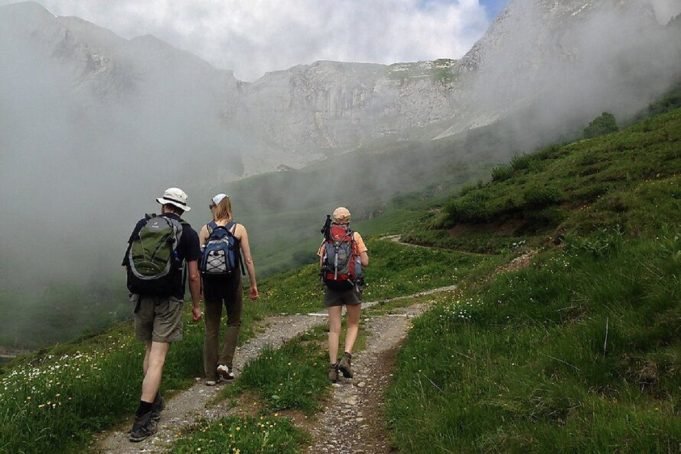Hiking can be a great way to stay active, enjoy the outdoors, and get much-needed exercise. Despite the pleasure it can bring, for many hikers, the joy of hitting the trails is often accompanied by plenty of discomfort and pain due to plantar fasciitis. Plantar fasciitis is a degenerative foot condition caused by inflammation of the tissue running along the bottom of the foot.
Those suffering from this condition often experience chronic heel and arch pain, which can be extremely unpleasant. In some cases, it may even make you feel like giving up on hiking and trying out a more sedentary pastime. However, this does not have to be the case. By taking the necessary precautions and selecting the right type of footwear, it is still possible to enjoy hiking safely, even with plantar fasciitis.
To ensure you stay comfortable during your outdoor activities, it is important to select the right kind of shoes, as well as to take breaks and stretch during your hike. Furthermore, wearing orthotic insoles can help to provide additional arch support and cushioning. Following these steps will help to reduce the pain and discomfort caused by plantar fasciitis and allow you to enjoy the great outdoors without worrying about your feet.
Understanding Plantar Fasciitis
In order to properly treat your condition, it is important to first understand exactly what it is. Plantar fasciitis is an inflammation of the tissue that runs along the bottom of your foot, from the heel to the toes, known as the plantar fascia. This ligament provides connecting points for the muscles and bones of your foot and helps to give your foot stability and support as you move and stand.
When it becomes overstretched or damaged due to a sudden change in activity level or due to overuse, the area becomes inflamed and can cause intense pain in the heel, arch, or ball of your foot. While the pain can be debilitating, with the right combination of rest, stretching, and other treatments, the inflammation can be reduced, and the pain can be relieved. It is important to take your time in the healing process, as rushing it can lead to further injury or re-injury. With patience and dedication to your treatment plan, you can manage the pain and inflammation associated with plantar fasciitis and return to your favorite activities.
Preventive Measures
Even when you have plantar fasciitis, you don’t have to miss out on all the joys of hiking. With any physical activity, it’s important to take preventive measures to keep your feet and overall health in tip-top shape. That’s why it’s essential to stretch your feet before hitting the trails. Taking the time to do a few minutes of stretching can help to improve blood flow, reduce tension and tightness in the muscles, and delay exhaustion which could lead to overuse and further inflammation.
Furthermore, be mindful of how you’re using your feet. Rather than landing too heavily on your heels, try to push off with your toes which can help to distribute the weight of your body more evenly. Additionally, keep the pace slow to conserve energy and put less strain on your feet and ligaments.
It’s also important to take regular breaks during your hikes. Sitting down or switching to an alternate form of exercise, like walking down a flat, level surface, can give your ligaments a much-needed break. As much as you may be tempted to keep going, it’s essential to listen to your body and ease up when pain or fatigue sets in.
Finally, keep your feet and the rest of your body cool and dry. Heat and sweat can increase inflammation and make your pain worse. Wear thin, breathable socks instead of cotton, as it tends to retain moisture and heat. Make sure to keep your feet dry and cool while you’re out on the trails. With these simple preventive measures, you can enjoy a hike even with plantar fasciitis.
Choosing the Right Shoes
One of the most important things that you can do to manage your plantar fasciitis symptoms is to choose the right shoes for your hikes. You’ll want a pair that can provide plenty of support and cushion without being overly heavy. Hiking boots can help to provide a supportive structure for your arch and overall foot health. Look for shoes with a hard, rigid sole and plenty of cushioning for your footbed.
When it comes to finding the best shoes for hiking with plantar fasciitis, Hoka Trail Running Shoes are a great choice. Not only do they provide plenty of cushioning and support, but they’re also lightweight as well. This makes these hiking boots for plantar fasciitis perfect for those long days on the trails and ensures that your feet won’t be bearing the burden of unnecessary strain or weight.
When you’re ready to take on the trails, make sure you have the right shoes, and you’ll be able to manage your symptoms and have a safe and fun time.
Stretching and Exercises for Plantar Fasciitis
Stretching and exercising can be an important part of treating and preventing pain from plantar fasciitis. Regular stretching can help to improve flexibility, reduce tension in the affected area, and promote blood flow, which can, in turn, reduce inflammation and pain. Some stretches that are especially helpful for plantar fasciitis include:
- Calf stretches: Stand facing a wall, place your hands on the wall, and step forward with your affected foot. Keep your back leg straight and your front knee bent. Hold for 20-30 seconds, then repeat with the other leg.
- Arch stretches: Place a rolled-up towel under the affected foot and use your toes to pull it towards you. Hold for 20-30 seconds, then repeat with the other foot.
- Toe raises: Stand with your feet hip-width apart and raise up onto the balls of your feet. Hold for 5 seconds, then lower your heels. Repeat 10-15 times.
Incorporating these stretches into your daily routine can help to reduce pain and improve the overall health of your feet.
Alternative Hiking Techniques
While plantar fasciitis can make hiking uncomfortable, there are alternative techniques that can help to reduce the stress on your feet and reduce pain. Some tips for hiking with plantar fasciitis include:
1. Hiking on flat terrain is a great way to get a good workout without having to worry about the dangers of steep inclines and declines. The flat terrain is ideal for those who want to take in the great outdoors but don’t want to put their body through the strain of constantly walking up and down hills. You’ll be able to travel for longer distances, take in the scenery, and still get an enjoyable and rewarding workout. Whether you’re a novice hiker or a seasoned veteran, hiking on flat terrain is an ideal way to get a great workout without having to worry about the risks of more difficult terrain.
2. Using trekking poles can be a great way to improve your hiking experience! Not only do they help to distribute your weight more evenly, reducing strain on your feet and legs, but they can also provide stability on uneven terrain, helping you to maintain your balance and keep you safe as you traverse the trail. Additionally, trekking poles can give you a much-needed break from the ground, allowing you to rest your arms and shoulders if you become fatigued during your journey. Trekking poles can be an invaluable aid when out on the trail and can make the difference between an enjoyable, successful journey and a difficult, exhausting experience.
3. Going for a walk on the softer ground can be a great way to get some exercise and enjoy the scenery around you. Instead of the usual hard concrete or asphalt, why not try going for a hike along a dirt or gravel trail? These types of trails are much more forgiving on your feet and joints and can provide a more enjoyable experience. Plus, you’ll be able to take in the sights and sounds of the natural environment, which can be a very calming and peaceful experience. So the next time you’re out for a walk or run, why not go for a hike on a soft surface? You’ll be glad you did!
By taking these alternative hiking techniques into consideration, you can enjoy the benefits of hiking without exacerbating your plantar fasciitis symptoms.
Importance of Gradual Increase in Activity
When dealing with plantar fasciitis, it is hugely important to increase your activity level in a gradual manner in order to avoid any further injury or pain. Start off with shorter hikes and then gradually increase the distance and intensity of your hikes as your body becomes more accustomed to the activity.
In addition, it is also very important to be aware of your body and to take breaks when necessary. If you start to experience discomfort or pain, it is best to stop the activity at once and rest until the pain subsides. Furthermore, during any activity, it is important to wear supportive shoes that fit properly and provide your feet with adequate cushioning and support. Additionally, to reduce the impact on your feet, try to vary your activities and choose low-impact alternatives where possible. Finally, try to stay well hydrated and take some time to stretch your feet and calves before and after any physical activity.
By gradually increasing your activity level, you can avoid exacerbating your plantar fasciitis symptoms and continue to enjoy the benefits of hiking without pain.
Parting Words
With the correct preventative measures and the proper equipment, plantar fasciitis doesn’t have to keep you from experiencing the beauty of the great outdoors. With the right precautions, you can still benefit from the wonderful activities that nature has to offer. This includes wearing supportive shoes and orthotics, stretching your feet and calf muscles regularly, using arch support, and using ice and heat therapy. Additionally, it’s important to take it easy and not overexert yourself. With these steps, you can still enjoy the wonders of nature without fear of further damage to your feet.















